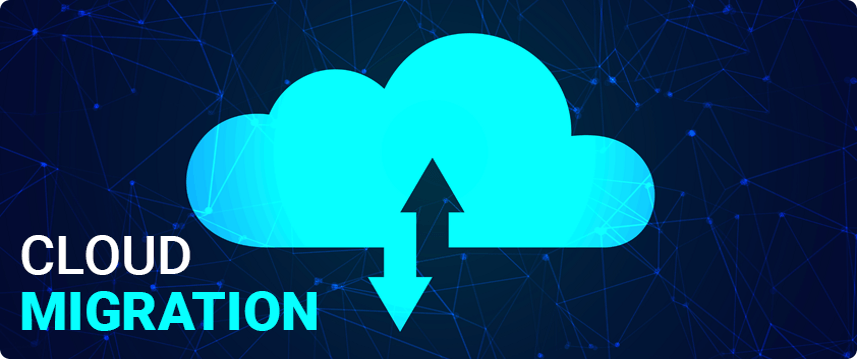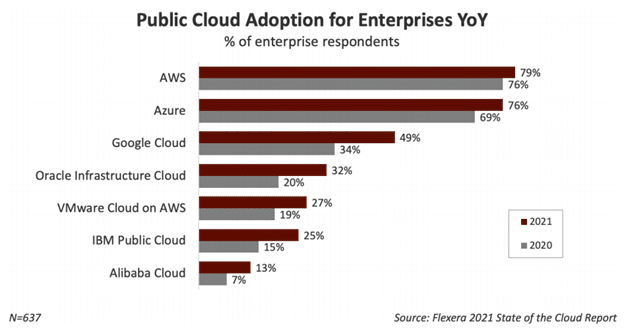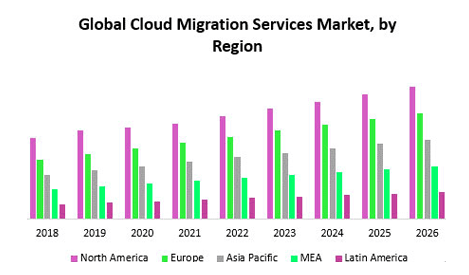
A cloud migration is when a company moves some or all its data center capabilities into the cloud, usually to run on the cloud-based infrastructure provided by a cloud service provider such as AWS, Google
Cloud, or Azure.
What are the Main Benefits of Migrating to the Cloud?
- Scalability - cloud computing can scale to support larger workloads and more users, much more easily than on-premises infrastructure. In traditional IT environments, companies had to purchase and set up physical servers, software licenses, storage and network equipment to scale up business services.
- Cost - cloud providers take over maintenance and upgrades, companies migrating to the cloud can spend significantly less on IT operations. They can devote more resources to innovation - developing new products or improving existing products.
- Performance - migrating to the cloud can improve performance and end-user experience. Applications and websites hosted in the cloud can easily scale to serve more users or higher throughput, and can run in geographical locations near to end-users, to reduce network latency.
- Digital experience - users can access cloud services and data from anywhere, whether they are employees or customers. This contributes to digital transformation, enables an improved experience for customers, and provides employees with modern, flexible tools.
What are Common Cloud Migration Challenges?
Cloud migrations can be complex and risky. Here are some of the major challenges facing many organizations as they transition resources to the cloud.
- Lack of Strategy : Many organizations start migrating to the cloud without devoting sufficient time and attention to their strategy. Successful cloud adoption and implementation requires rigorous end-to-end cloud migration planning. Each application and dataset may have different requirements and considerations and may require a different approach to cloud migration. The organization must have a clear business case for each workload it migrates to the cloud.
- Cost Management : When migrating to the cloud, many organizations have not set clear KPIs to understand what they plan to spend or save after migration. This makes it difficult to understand if migration was successful, from an economic point of view. In addition, cloud environments are dynamic, and costs can change rapidly as new services are adopted and application usage grows.
- Vendor Lock-In : Vendor lock-in is a common problem for adopters of cloud technology. Cloud providers offer a large variety of services, but many of them cannot be extended to other cloud platforms. Migrating workloads from one cloud to another is a lengthy and costly process. Many organizations start using cloud services, and later find it difficult to switch providers if the current provider doesn't suit their requirements.
- Data Security and Compliance : One of the major obstacles to cloud migration is data security and compliance. Cloud services use a shared responsibility model, where they take responsibility for securing the infrastructure, and the customer is responsible for securing data and workloads.
Cloud Migration Strategies
Gartner has identified five cloud migration techniques, known as the “5 Rs”. Organizations looking to migrate to the cloud should consider which migration strategy best answers their needs. The following is a brief description of each
- Rehost : Rehosting, or ‘lift and shift,’ involves using infrastructure-as-a-service (IaaS). You simply redeploy your existing data and applications on the cloud server. This is easy to do and is thus suited for organizations less familiar with cloud environments. It is also a good option for cases where it is difficult to modify the code, and you want to migrate your applications intact.
- Refactor : Refactoring, or ‘lift, tinker, and shift,’ is when you tweak and optimize your applications for the cloud. In this case, a platform-as-a-service (PaaS) model is employed. The core architecture of the applications remains unchanged, but adjustments are made to enable the better use of cloud-based tools.
- Revise : Revising builds upon the previous strategies, requiring more significant changes to the architecture and code of the systems being moved to the cloud. This is done to enable applications to take full advantage of the services available in the cloud, which may require introducing major code changes. This strategy requires foreplaning and advanced knowledge.
- Rebuild : Rebuilding takes the Revise approach even further by discarding the existing code base and replacing it with a new one. This process takes a lot of time and is only considered when companies decide that their existing solutions don’t meet current business needs.
- Replace : Replacing is another solution to the challenges that inform the Rebuild approach. The difference here is that the company doesn’t redevelop its own native application from scratch. This involves migrating to a third-party, prebuilt application provided by the vendor. The only thing that you migrate from your existing application is the data, while everything else about the system is new.
Types of cloud computing
-
Public cloud
- With public cloud, services are owned and run by a third-party vendor (called a cloud service provider) over the public internet. These services can be free or available as pay-per-use to anyone who wishes to use or buy them. The advantages of public cloud are huge, which might explain why it’s the most common type of deployment.
- Examples of public clouds include Amazon Web Services (AWS), Microsoft Azure, Google Cloud Platform (GCP), Alibaba Cloud, IBM Cloud, and Oracle Cloud.
- The advantages of public cloud include 24/7 uptime, the ability to only pay for what you use (which can result in cost savings), scalability, and simplified infrastructure management — meaning setup is simple and there’s no need to buy and manage on-premises infrastructure.
-
Private cloud
- With private cloud, cloud resources are used and owned solely by one organization. That makes this approach desirable by governmental and financial industries that seek maximum control or customization. The private cloud may be in a data center on-site or hosted by a provider in a remote location.
- Private cloud providers include Hewlett Packard Enterprise (HPE), Dell, IBM, Oracle, and some familiar names from the public cloud provider space, including AWS, Google, and Microsoft.
-
Hybrid cloud
- Hybrid cloud combines elements of private and public cloud and allows resources to move between the two. Hybrid cloud works well for organizations that need an element of private cloud (for example, regulation requirements around sensitive data) but still want access to public cloud and its big benefits.
- Hybrid cloud combines elements of private and public cloud and allows resources to move between the two. Hybrid cloud works well for organizations that need an element of private cloud (for example, regulation requirements around sensitive data) but still want access to public cloud and its big benefits.
-
Multicloud
- Multicloud is the use of multiple cloud services in a single environment. This can mean, for example, a mix of public and private clouds or using a mix of public cloud providers to reduce reliance on a single provider or to realize the benefits of more than one provider.
- Multicloud is the most popular cloud strategy among enterprises.
- Multicloud refers to using multiple services (like services from AWS and Azure), while hybrid cloud refers to using multiple deployment models (like using public and private cloud).
Cloud service models
-
SaaS
- Software as a Service, or SaaS, is software provided over the internet. Nothing is installed on a local computer, tablet, or phone; no one is needed to manage things like patches or updates. It just works.
- Examples of SaaS include Dropbox, Salesforce, the G Suite apps (like Gmail), and Microsoft 365.
-
PaaS
- PaaS, or Platform as a Service, is a software building ground for developers. PaaS provides a blank slate in the cloud that lets the developers create, deploy, and scale applications without having to sweat things like infrastructure, storage, or operating systems.
- Examples of PaaS include AWS Elastic Beanstalk, OpenShift, and Google App Engine.
-
IaaS
- Infrastructure as a Service, or IaaS, means moving infrastructure into the cloud. (Think : renting a server in the cloud.) Your cloud provider owns the hardware and is responsible for managing and maintaining it, so you don’t have to worry about any maintenance.
- Examples of IaaS include AWS, Microsoft Azure, Google Cloud Platform, Rackspace, and DigitalOcean.
Cloud migration tools and services
| AWS | Azure | Google Cloud | |
|---|---|---|---|
| Database migration | AWS Database Migration Service | Azure Database Migration Service | Database Migration Service (preview) |
| Data transfer appliance | Snow Family | Data Box | Transfer Appliance |
| Disaster recovery | CloudEndure Disaster Recovery | Azure Site Recovery | N/A |
| Online data transfer | AWS DataSync, AWS Transfer Family | Azure File Sync | BigQuery Data Transfer Service, Cloud Data Transfer |
| On-premises application analysis | AWS Application Discovery Service, Migration Evaluator | Azure Migrate, Movere, Azure Resource Mover | N/A |
| On-premises and cloud storage integration | Storage Gateway | StorSimple | N/A (offered by partner Cloudian) |
| Migration tracker | AWS Migration Hub | Azure Migrate | N/A |
| Server migration | AWS App2Container, AWS Server Migration Service, CloudEndure Migration | Azure Migrate | Migrate for Anthos, Migrate for Compute Engine, VM migration |
A 10-Step Cloud Migration Checklist
- Establish the migration-architect role : Before you begin your cloud migration, establish the migration architect role to lead the effort. The migration architect is a system architect-level position responsible for planning and completing all aspects of the migration; their core responsibility should include defining necessary refactoring required to make the migration successful, designing strategies for data migration, defining cloud-solution requirements, and determining migration priorities and production switchover mechanisms.
-
Choose your level of cloud integration : When you move an application from an on-premises data center to the cloud, there are two ways you can migrate your application—a shallow cloud integration
or a deep cloud integration.
- For ashallow cloud integrationa. (sometimes called “lift-and-shift”), you move the on-premises application to the cloud and make no—or limited—changes to the servers you instantiate in the cloud for the purpose of running the application. Any application changes are just enough to get it to run in the new environment. You don’t use cloud-unique services. This model is also known as lift-and-shift because the application is lifted “as is” and moved, or shifted, to the cloud intact.
- For adeep cloud integration, you modify your application during the migration process to take advantage of key cloud capabilities. This might be nothing more advanced than using auto-scaling and dynamic load balancing, or it might be as sophisticated as utilizing serverless computing capabilities such as AWS Lambda for portions of the application. It might also involve using a cloud-specific data store such as Amazon S3 or DynamoDB.
- Choose a single cloud or go multi-cloud : Before you begin your cloud migration, address this question : Do you want to pick a single cloud provider and migrate your application, so it runs optimized for that single environment, or do you want your application to run on multiple cloud providers?
- Establish cloud KPIs : Key Performance Indicators (KPIs) are metrics that you gather about your application or service to measure how it is performing against your expectations. You may already have defined some KPIs for your applications and services, but are they still the right ones for an application or service once it’s in the cloud? The best KPIs for a cloud migration show how you’re in-progress migration is doing, illuminating visible or invisible problems that may be lurking within your application. Most important, perhaps, cloud migration KPIs can help you determine when the migration is complete and successful.
- Establish performance baselines : Baselining is the process of measuring the current (pre-migration) performance of your application or service in order to determine if its future (post-migration) performance is acceptable. Baselines help you determine when your migration is complete and provide validation of the post-migration performance improvements you expected. You can also refer to baselines during a cloud migration to diagnose any problems that arise. Set a baseline metric for each KPI that you’ve decided to measure. Determine how long you will collect data to determine the baseline. Choosing a short baseline period (such as a day) lets you move faster, but you risk not collecting a representative performance sample. Choosing a longer period to baseline (such as a month) obviously takes more time but can provide more representative data.
- Prioritize migration components : You also must decide if you will migrate your entire application at once, or if you will migrate it to the cloud component by component or service by service. First, identify the connections between your services, and which services depend on what other services. For larger, more complex applications, use an application performance monitoring tool that can use service maps to generate dependency diagrams. Use the dependency diagram to decide which components should be migrated and in what order.
- Perform any necessary refactoring : It works effectively with a variable number of running instances to allow dynamic scaling, potentially saving you money on cloud service costs. So, your resource utilization can better take advantage of dynamic-cloud capabilities, such as the ability to dynamically allocate and de-allocate resources as needed, rather than you statically allocating them ahead of time. To move to a more service-oriented architecture before the migration, so that you can more easily move individual services to the cloud.
- Create a data-migration plan : Migrating data is one of the trickiest parts of a cloud migration. The location of your data can significantly impact the performance of your application. Moving your data to the cloud when the data-access methods are still primarily on-premises can significantly impact performance. The same holds true if the data is still on-premises but the service accessing it resides in the cloud.
- Switch over production : When and how do you switch over the production system from the legacy on-premises solution to the new cloud version? The answer depends on the complexity and architecture of your application, and especially the architecture of your data and datastores.
- Review application resource allocation : Even after you’ve finished migrating everything to the cloud, there are a few more things to consider. Most important is resource optimization. The cloud is optimized for dynamic resource allocation, and when you allocate resources (servers, for example) statically, you’re not taking advantage of the cloud’s strengths. As you move into the cloud, make sure your teams have a plan for distributing resources to your application. When you need to allocate additional resources to an application in the cloud, they are usually available from the vendor in virtually any quantity in a moment’s notice.


Conclusion
Accelerate your cloud migration using the above-mentioned cloud migration steps. The first step of a cloud migration strategy must be to create a cloud migration checklist. The rate of cloud adoption is
higher, but there is a shortage of professionals with a cloud skillset. Trajectus has taken a responsibility to avail remote cloud talents to the organizations that planning for cloud migration. Just let us
know your requirement and we’ll reach out to you soon. Hoping to hear from you.












